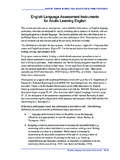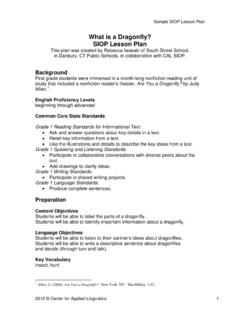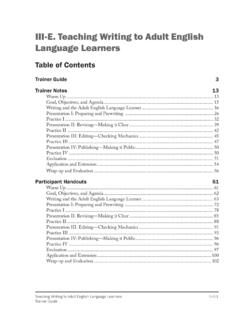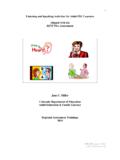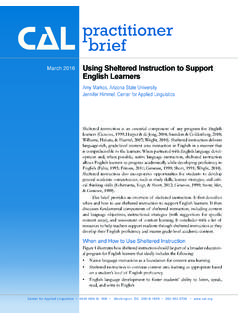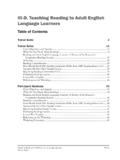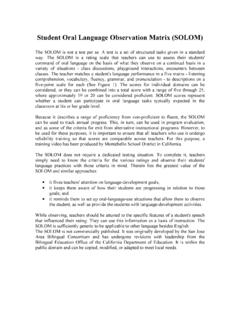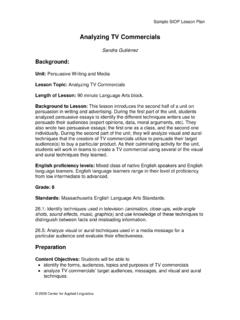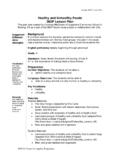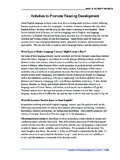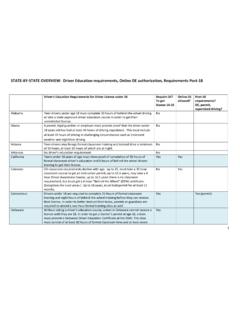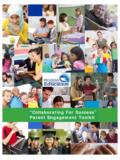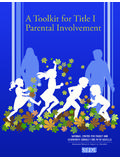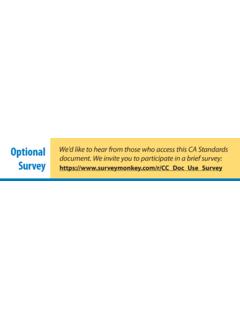Transcription of Parent Education Activities - Center for Applied Linguistics
1 _____PART III: Parent Education Parent Education Activities III 9 Parent Education Activities Parent Education sessions need to be planned and should follow a similar sequence each time. The suggested sequence is listed here and is explained later in this article. Also, see Sample Parent Education Lessons beginning on page III 17 for examples. Engaging parents in a short, motivating, introductory activity Presenting new information Processing the information through Activities Helping parents apply the new information Topics may vary, but the majority of the sessions should Center on the language and literacy development of children.
2 It takes careful planning to provide opportunities for parents to learn about their child s language and literacy development, as well as opportunities for parents to discuss and gain the skills to support this development. Often, Parent Education sessions provide the opportunity to dispel common misconceptions regarding children s language and literacy development. Discussing strategies or Activities with parents that support their child s learning is a fundamental goal of Parent Education . These Activities should be appropriate for the age of the child and can be done in the Parent s native language.
3 Figure III 3 provides some tips from the Reading Rockets Web site ( ) to share with parents . Figure III 3: Parent Tips for Developing Language and Literacy in Children Infants: Talk and sing to your baby when you change his diaper, give him a bath, feed him lunch, or join him in play. Help increase your baby s vocabulary by asking What s that? or Where s the dog? when looking at and enjoying books together. Toddlers: Read stories before bedtime. It makes a good transition between active play and rest time. Take short trips to new places and talk about what is happening around you. Preschoolers: Encourage preschool children to carry out steps to written recipes or to look at labels.
4 Play picture-card games with your child. Point out words on signs. Primary grade children: Continue to read with your child even if he has already learned to read. Visit the library on a regular basis. Show children that you read books and magazines for information and enjoyment. (Adapted from National Association for the Education of Young Children, 1997.) PART III: Parent Education _____ III 10 Parent Education Activities The Learning to Read and Write overview below (adapted from Neuman, Copple & Bredekamp, 2000) is a broad look at children s language and literacy development from birth to approximately age eight, including children with special needs, children from diverse cultures and English language learners.
5 Teachers may encourage parents to consider and discuss ways to incorporate the following aspects of literacy development into their family routines: The Power and Pleasure of Literacy. Children s success with language and literacy requires opportunities to enjoy and value the power that comes with literacy. A critical feature that supports this enjoyment is meaningful interactions with adults through positive literacy experiences. When children see parents reading for pleasure, children see reading as a positive activity. The Literate Environment. A literate environment provides opportunities to broaden social knowledge and language development.
6 It includes use of print in purposeful ways, language-rich experiences with others, a variety and abundance of literacy materials, and representations of varied cultural and linguistic backgrounds. Language Development. Language development involves understanding the role of language skills and word knowledge in meaningful contexts. It is important that children experience a large quantity of discourse and a variety of language. How language is used in home and educational settings influences children s literacy learning. Building Knowledge and Comprehension. Through enriching experiences with their families and in educational settings, children build knowledge that allows them to assimilate new learning and refine knowledge and concepts.
7 Phonological Awareness. In infancy, children begin to attend to the sounds of speech. Gradually children become more aware of the sounds around them that eventually lead to making connections between sounds and letters. Letters and Words. To become proficient readers, children learn that letters of the alphabet form patterns to become words. In becoming skilled readers, they are able to use their beginning knowledge of letters and words to increase word recognition and support their efforts to read and write. Types of Text. When children become familiar with, experience, and distinguish different types of text (such as stories, conversations, poetry, dramatization, and messages) they are able to read and create these forms themselves.
8 Knowledge of Print. Children develop knowledge of print when they observe and interact with others as they read, write, and use print for many purposes. In addition, children s awareness of letters, the general shape and length of familiar words, the mechanics of reading and writing, and features of text increase their knowledge of print and how it works. _____PART III: Parent Education Parent Education Activities III 11 Planning Parent Education Sessions In some family literacy programs, parents attend regularly scheduled group sessions facilitated by a Parent educator. In other programs, staff members may alternatively lead Parent Education sessions.
9 Thus, it is important that all staff members be sensitized to the various cultural aspects of the families enrolled. Parent Education sessions involve various planning steps, beginning with the identification of a topic about which parents want to learn. Some examples might be learning how children s cognitive abilities develop and grow, learning how to read a book with your child, or even learning how to help a school-age child with homework. Figure III 4 displays a typical Parent Education lesson format. Figure III 4: Parent Education Lesson Format 1. Engaging parents in a short motivating introductory activity 2.
10 Presenting new information using a video, an article, a guest speaker, or a children s book 3. Processing the information through Activities such as a discussion, writing on the topic, role-playing, or playing a game 4. Helping parents apply the new information in their own lives Typical Parent Education Lesson The following is an example of a typical Parent Education lesson. This example is based on a program that serves parents and their young children. The teacher knows the parents can read the books she has chosen. For parents who have very low English literacy skills, the activity could be adapted by encouraging the parents to tell a story, by using picture books, or by providing books in the Parent s native language.
